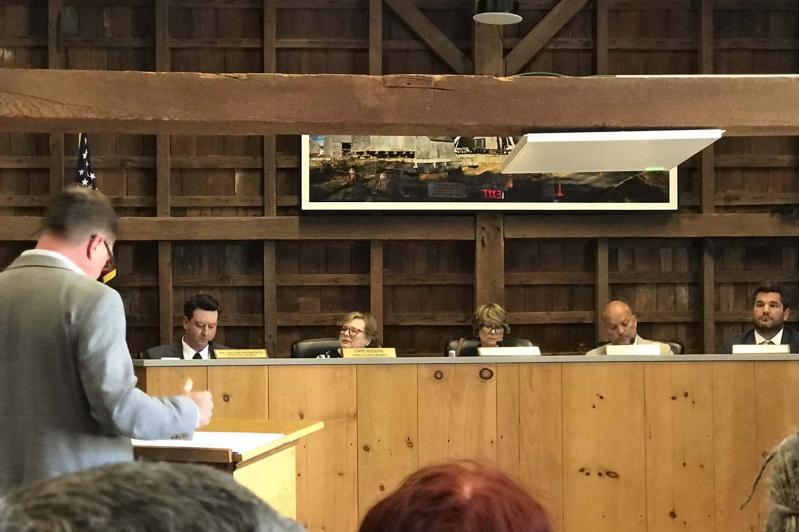The maximum allowable size of a single-family residence in East Hampton Town should be sliced in half, from 20,000 square feet to 10,000, a working group looking at sweeping zoning code amendments told the town board on Tuesday.
That was one of several key recommendations made by the group, which has been meeting for over a year. Another key proposal, which proved controversial, was to include finished basements and attached garages in calculating a house’s gross floor area. Under current code, the square footage in those areas is not added to the total size of a house on its certificate of occupancy.
Any changes made would apply to new construction going forward, not retroactively enforced.
“It’s worth noting that you can’t build a big box store in this town that’s bigger than 15,000 square feet, but our largest house size is 5,000 feet larger,” said Jeremy Samuelson, the town’s planning director and a member of the zoning code amendment group. The maximum of 10,000 square feet would only come into play on lots that are over two acres, because any lot smaller than
two acres would already be precluded from having a house of that size.
“How big is a house? That’s what this whole conversation is. Should all of the structure be counted or just part of the structure?” he asked.
Mr. Samuelson put the discussion in the context of the town’s comprehensive plan, and stressed that his presentation, which lasted nearly two hours and drew an additional hour of public comment, was only the beginning of the conversation.
“There’s a disconnect between the zoning code and how it’s being applied and the G.F.A.s and standards the community set for itself under the comprehensive plan.” He said that people could disagree about how big a house needs to be, but that loopholes were causing houses to expand well beyond what’s reflected on their certificates of occupancy, and in contrast to the stated objectives of the town’s comprehensive plan.
“We should all agree on the need to count what is actually built and have that accurately reflected on the certificate of occupancy. That’s the big hairy audacious idea that we’re here to present to you today.”
The town uses a formula to calculate maximum allowable gross floor area based on lot size: 10 percent of the lot area plus 1,600 square feet. The formula itself was not under scrutiny. Mr. Samuelson provided three examples of houses that greatly exceeded their gross floor area limits, one nearly twice the number, because the basements essentially acted as third stories, or only the habitable spaces above the garages were counted, and not the garages themselves.
“Right now, we don’t count attached garages and what’s below ground. The proposal today is to put both of those pieces into the equation,” he said. “The equation only works if it includes the things you’re building. I don’t know how you put the blinders on and ignore the 4,500 square feet of finished space that includes two bedrooms. We set standards for house size but we’re ignoring and living well outside those standards.”
They’re called “iceberg houses,” these houses with basements that extend in some instances past the foundation of the upper stories, because what’s unseen can be larger than what’s seen.
Councilwoman Cate Rogers, who is also part of the zoning code amendments work group, said that town code already limits residences to two stories, which is defined as any part of a structure four feet above grade. “What we’re seeing now, folks aren’t building them above grade. They’re digging below grade to have that walkout and we have nothing in the code to prevent digging down.”
Councilman David Lys had some concerns. Impacts could be felt disproportionately on homeowners with smaller lot sizes, he said. He wondered whether, if gross floor area were counted in basements, the unintended consequence would be that people would move that massing back above ground. Perhaps only a percentage of the finished space could be counted, he suggested. He also said cutting the maximum allowable house size in half was “too limiting.”
Picking up on Councilman Lys’s comments about adding finished basements to the G.F.A. calculation, Councilman Ian Calder-Piedmonte said, “Sometimes in an attempt to prevent the wealthy from taking advantage, we are making it harder to be a regular person in the community.” He mentioned a recommendation the group made to require topographic maps when applying for a building permit. “If we go to a flat property, and someone is building a modest house, and they’re not up against the pyramid, can we make sure that they can waive that?”
“I think if you have a garage with your kids’ bikes and paper towels from Costco, I don’t know if that should be counted towards G.F.A.,” said Supervisor Kathee Burke-Gonzalez. “I voted to not count basements in G.F.A. in 2016. I had good reason. What disturbs me most is the ‘walk-out-abilty.’ To me, that’s clearly a third story.” But she took no issue with below-ground finished basements in general. If they were counted, “it could lead to more mass and volume on the second and third floor.”
The room was packed with builders, real estate agents, architects, surveyors, and land-use lawyers who gave the town board and Mr. Samuelson plenty of feedback. Larry Kane, a builder, said more of them should be involved in the process. “Bring in builders, architects, and we will come up with good code for generations to come.”
“Zoning is all about affecting your neighbors,” said Jon Tarbet, a lawyer. “If someone’s basement is finished or unfinished you don’t know. No one is going to build below ground if it comes out of what you can build above ground. If I own a half-acre lot, I’m just not going to build a basement, I’ll build it all above ground. This is going to make houses look bigger.” The super-rich will get around the law, he said. “You’re killing half-acre lot owners because their homes will become pre-existing nonconforming. They can’t bump out their 2,500-square-foot house to add an office, or bathroom. They’ll have to apply for a variance, which will take two years and may or may not be approved. I would love to not see this applied to B-zone properties.” (B-Zone properties are just under half an acre.)
“Counting an attached garage is a good thing because it goes to massing,” said Phillip O’Connell, a member of the East Hampton Village Zoning Board of Appeals, who was speaking as a private citizen. “But G.F.A. in basements doesn’t go to massing. I don’t think that’s a good idea.”
“It’s never too late to not do something stupid,” he added.
Other recommendations received less comment. The group advised that distance to groundwater be considered for all structures, not just septic systems. (“An elevated water table is a new reality for us,” said Mr. Samuelson. “All we are simply saying is, don’t build in the water table.”) Railings on rooftop decks should match the state standard for commercial, not residential buildings, because houses are often rented out. (“I think it’s fair to say that many times the people who may be enjoying a roof deck are not necessarily the long-term occupants of that house,” said Mr. Samuelson.) Glass railings should be included in building height, and the maximum height of accessory structures, other than affordable accessory apartments, should be set at 15 feet for a flat roof, or 20 feet for a gabled roof, the work group recommended.
“In order to start the conversation with the community we have to have something to present,” said Councilwoman Rogers. “I look forward to continuing this conversation. When we have community input and all come to the table, that’s when we come up with the best solutions.”




